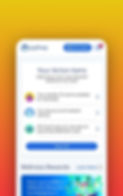
Project: Healthpass
In the wake of the post-COVID era, we were tasked with developing an accessible, user-friendly, and easily updatable record-keeping system to track users' vaccinations. Given the highly debated nature of the vaccine, this was both a politically sensitive and deeply personal endeavor. Additionally, we recognized the challenges faced by users with cognitive impairments who might struggle to recall their vaccination history. It became evident that we needed a reliable system to catalog COVID vaccinations while also providing a secure and trusted method for individuals in states with vaccine requirements to verify their immunization status.
Tools
Figma
My Role
Product Designer
Support Designer
Partnered with stakeholders to research, analyze, and identify the best solution for the HealthPass, translating insights into user flows, wireframes, and high-fidelity mockups to enhance usability and overall experience.
Timeline
3 months
The Task
1. User Managed → Simplicity
This experience would be managed completely by users and/or caretakers
2. Updatable → Intuib
Adding vaccinations to the Healthpass needed to be intuitive and simple.
3. Network Limitations → Reliable
This side of the app needed to be lightweight in order to be accessible where network services may be limited
4. Budget & Time → Needed it "Yesterday"
With certain states now requiring proof of immunizations for the some to return to work or use public facilities we knew we had to move quickly.

Opportunity
Create a reliable and manageable feature that provides users a convenient trackable immunization record.

The Numbers
User Statistics (February 2021)
General User Metrics:
-
Total Users: 250,000
-
New Users This Month: 85,000
-
Active Users (Last 30 Days): 190,000
-
Daily Active Users (DAU): 35,000
-
Retention Rate: 65%
User Engagement & Behavior:
-
Average Time Spent on App: 4m 45s
-
Users Who Updated Their Records: 70,000
-
Users Who Downloaded a Digital Vaccine Pass: 110,000
-
Most Common Upload Method: Mobile Camera (82%), File Upload (18%)
Demographic Insights:
-
Top Age Groups: 35-44 (38%), 45-54 (30%), 25-34 (20%)
-
Top Locations: New York (15%), California (13%), Florida (9%), Illinois (7%)
-
Primary Device Used: Mobile (85%)
Support & Issues:
-
User Support Requests: 12,000
-
Most Common Issue: Verification Delays (55%), Upload Errors (28%), Account Access Issues (12%)
-
Resolution Time (Avg): 6.2 hours

Our
Findings
Despite budget and time constraints, we successfully delivered an intuitive design that empowered users to manage their immunization records with ease. Additionally, we proactively planned for seamless integration with the native iOS Wallet app to enhance accessibility and user convenience.
Throughout the design process, prioritizing iterative improvements based on user feedback and testing. By conducting usability testing at key milestones, I identified pain points and refined interactions to enhance clarity and efficiency. This user-centered approach allowed us to optimize the design for accessibility, ensuring a seamless experience for individuals of all cognitive and technical abilities.
More From Anthem
Refining
As Product Designers, part of our responsibility is to continuously refine and iterate on established design patterns to enhance usability and clarity. At Anthem, we frequently revisited our designs, whether driven by internal assessments or direct user feedback, to ensure we were delivering the best possible experience.
In one instance, user testing revealed that 60% of participants did not recognize Pharmacy Orders as interactive elements and struggled to interpret our Secondary Button as an actionable link. To address this, we refined the design to improve clarity and affordance. Upon testing our updated iteration, all 100 participants correctly identified and understood the interactive elements, validating the impact of these refinements. This iterative approach ensures that our designs remain intuitive, accessible, and user-centered.
Sometimes the smallest changes create the biggest impact
